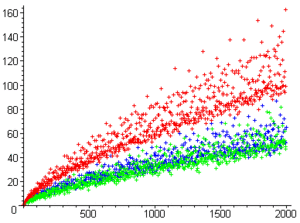حدسية جولدباخ
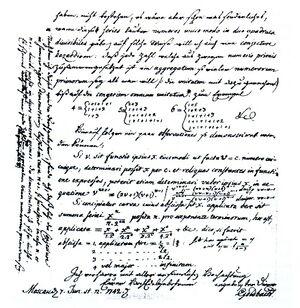 Letter from Goldbach to Euler dated on 7 June 1742 (Latin-German)[1] | |
| المجال | Number theory |
|---|---|
| حدسها | Christian Goldbach |
| حدسية في | 1742 |
| مسألة مفتوحة | Yes |
| عواقب | Goldbach's weak conjecture |
حدسية گولدباخ اكتشفها كرستيان گولدباخ، وتنص على أن كل عدد صحيح طبيعي زوجي أكبر من 2 يمكن كتابته على شكل مجموع عددين أوليين.
وقد أكدها كمبيوتر لأعداد هائلة - على الأقل حتى 4 × 1018 - إلا أنها مازالت غير مبرهنة.
حدسية گولدباخ يمكن كتابتها في التدوين المنطقي كالتالي:
عدد گولدباخ
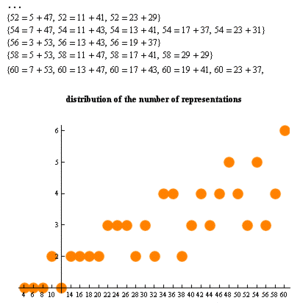
أمثلة:
- 4=2+2
- 6=3+3
- 8=3+5
- 10=5+5=3+7
- 12=5+7
- 14=7+7=3+11
- 16=5+11=3+13
- 18=7+11=5+13
- 20=3+17=7+13
- 22=3+19=5+17
- 24=5+19=7+17
التبرير الارشادي
where the product is over all primes p, and is the number of solutions to the equation in modular arithmetic, subject to the constraints . This formula has been rigorously proven to be asymptotically valid for c ≥ 3 from the work of Vinogradov, but is still only a conjecture when . In the latter case, the above formula simplifies to 0 when n is odd, and to
when n is even, where is the twin prime constant
وتلك أحياً تُعرف بإسم حدسية گولدباخ الموسعة. وفي الواقع فإن حدسية گولدباخ القوية شبيهة جداً بـ twin prime conjecture, and the two conjectures are believed to be of roughly comparable difficulty.
The Goldbach partition functions shown here can be displayed as histograms which informatively illustrate the above equations. طالع مذنب گولدباخ.[4]
التاريخ
On 7 June 1742, the German mathematician Christian Goldbach wrote a letter to Leonhard Euler (letter XLIII),[5] in which he proposed the following conjecture:
Goldbach was following the now-abandoned convention of considering 1 to be a prime number,[6] so that a sum of units would indeed be a sum of primes. He then proposed a second conjecture in the margin of his letter, which implies the first:[7]
... eine jede Zahl, die grösser ist als 2, ein aggregatum trium numerorum primorum sey.
Every integer greater than 2 can be written as the sum of three primes.
Euler replied in a letter dated 30 June 1742[8] and reminded Goldbach of an earlier conversation they had had ("... so Ew vormals mit mir communicirt haben ..."), in which Goldbach had remarked that the first of those two conjectures would follow from the statement
This is in fact equivalent to his second, marginal conjecture. In the letter dated 30 June 1742, Euler stated:[9][10]
Dass ... ein jeder numerus par eine summa duorum primorum sey, halte ich für ein ganz gewisses theorema, ungeachtet ich dasselbe nicht demonstriren kann.
That ... every even integer is a sum of two primes, I regard as a completely certain theorem, although I cannot prove it.
Each of the three conjectures above has a natural analog in terms of the modern definition of a prime, under which 1 is excluded. A modern version of the first conjecture is:
A modern version of the marginal conjecture is:
And a modern version of Goldbach's older conjecture of which Euler reminded him is:
These modern versions might not be entirely equivalent to the corresponding original statements. For example, if there were an even integer larger than 4, for a prime, that could not be expressed as the sum of two primes in the modern sense, then it would be a counterexample to the modern version of the third conjecture (without being a counterexample to the original version). The modern version is thus probably stronger (but in order to confirm that, one would have to prove that the first version, freely applied to any positive even integer , could not possibly rule out the existence of such a specific counterexample ). In any case, the modern statements have the same relationships with each other as the older statements did. That is, the second and third modern statements are equivalent, and either implies the first modern statement.
The third modern statement (equivalent to the second) is the form in which the conjecture is usually expressed today. It is also known as the "strong", "even", or "binary" Goldbach conjecture. A weaker form of the second modern statement, known as "Goldbach's weak conjecture", the "odd Goldbach conjecture", or the "ternary Goldbach conjecture", asserts that
A proof for the weak conjecture was proposed in 2013 by Harald Helfgott. Helfgott's proof has not yet appeared in a peer-reviewed publication, though was accepted for publication in the Annals of Mathematics Studies series[11] in 2015 and has been undergoing further review and revision since.[12][13][14] The weak conjecture would be a corollary of the strong conjecture: if n − 3 is a sum of two primes, then n is a sum of three primes. However, the converse implication and thus the strong Goldbach conjecture remain unproven.
Verified results
For small values of n, the strong Goldbach conjecture (and hence the weak Goldbach conjecture) can be verified directly. For instance, in 1938, Nils Pipping laboriously verified the conjecture up to n ≤ 105.[15] With the advent of computers, many more values of n have been checked; T. Oliveira e Silva ran a distributed computer search that has verified the conjecture for n ≤ 4 × 1018 (and double-checked up to 4 × 1017) as of 2013. One record from this search is that 3325581707333960528 is the smallest number that cannot be written as a sum of two primes where one is smaller than 9781.[16]
Heuristic justification
Statistical considerations that focus on the probabilistic distribution of prime numbers present informal evidence in favour of the conjecture (in both the weak and strong forms) for sufficiently large integers: the greater the integer, the more ways there are available for that number to be represented as the sum of two or three other numbers, and the more "likely" it becomes that at least one of these representations consists entirely of primes.
A very crude version of the heuristic probabilistic argument (for the strong form of the Goldbach conjecture) is as follows. The prime number theorem asserts that an integer m selected at random has roughly a chance of being prime. Thus if n is a large even integer and m is a number between 3 and n/2, then one might expect the probability of m and n − m simultaneously being prime to be . If one pursues this heuristic, one might expect the total number of ways to write a large even integer n as the sum of two odd primes to be roughly
Since , this quantity goes to infinity as n increases, and one would expect that every large even integer has not just one representation as the sum of two primes, but in fact very many such representations.
This heuristic argument is actually somewhat inaccurate, because it assumes that the events of m and n − m being prime are statistically independent of each other. For instance, if m is odd, then n − m is also odd, and if m is even, then n − m is even, a non-trivial relation because, besides the number 2, only odd numbers can be prime. Similarly, if n is divisible by 3, and m was already a prime distinct from 3, then n − m would also be coprime to 3 and thus be slightly more likely to be prime than a general number. Pursuing this type of analysis more carefully, G. H. Hardy and John Edensor Littlewood in 1923 conjectured (as part of their Hardy–Littlewood prime tuple conjecture) that for any fixed c ≥ 2, the number of representations of a large integer n as the sum of c primes with should be asymptotically equal to
where the product is over all primes p, and is the number of solutions to the equation in modular arithmetic, subject to the constraints . This formula has been rigorously proven to be asymptotically valid for c ≥ 3 from the work of Ivan Matveevich Vinogradov, but is still only a conjecture when .[بحاجة لمصدر] In the latter case, the above formula simplifies to 0 when n is odd, and to
when n is even, where is Hardy–Littlewood's twin prime constant
This is sometimes known as the extended Goldbach conjecture. The strong Goldbach conjecture is in fact very similar to the twin prime conjecture, and the two conjectures are believed to be of roughly comparable difficulty.
The Goldbach partition function is the function that associates to each even integer the number of ways it can be decomposed into a sum of two primes. Its graph looks as a comet, and is therefore called Goldbach's comet.[17]
Goldbach's comet suggests tight upper and lower bounds on the number of representations of an even number as the sum of two primes, and also that the number of these representations depend strongly on the value modulo 3 of the number.
Rigorous results
The strong Goldbach conjecture is much more difficult than the weak Goldbach conjecture. Using Vinogradov's method, Nikolai Chudakov,[18] Johannes van der Corput,[19] and Theodor Estermann[20] showed that almost all even numbers can be written as the sum of two primes (in the sense that the fraction of even numbers up to some which can be so written tends towards 1 as increases). In 1930, Lev Schnirelmann proved that any natural number greater than 1 can be written as the sum of not more than C prime numbers, where C is an effectively computable constant; see Schnirelmann density.[21][22] Schnirelmann's constant is the lowest number C with this property. Schnirelmann himself obtained C < 800000. This result was subsequently enhanced by many authors, such as Olivier Ramaré, who in 1995 showed that every even number n ≥ 4 is in fact the sum of at most 6 primes. The best known result currently stems from the proof of the weak Goldbach conjecture by Harald Helfgott,[23] which directly implies that every even number n ≥ 4 is the sum of at most 4 primes.[24][25]
In 1924, Hardy and Littlewood showed under the assumption of the generalized Riemann hypothesis that the number of even numbers up to X violating the Goldbach conjecture is much less than for small c.[26]
In 1948, using sieve theory, Alfréd Rényi showed that every sufficiently large even number can be written as the sum of a prime and an almost prime with at most K factors.[27] Chen Jingrun showed in 1973 using the methods of sieve theory that every sufficiently large even number can be written as the sum of either two primes, or a prime and a semiprime (the product of two primes).[28] See Chen's theorem for further information.
In 1975, Hugh Montgomery and Robert Charles Vaughan showed that "most" even numbers are expressible as the sum of two primes. More precisely, they showed that there exist positive constants c and C such that for all sufficiently large numbers N, every even number less than N is the sum of two primes, with at most exceptions. In particular, the set of even integers that are not the sum of two primes has density zero.
In 1951, Yuri Linnik proved the existence of a constant K such that every sufficiently large even number is the sum of two primes and at most K powers of 2. Roger Heath-Brown and Jan-Christoph Schlage-Puchta found in 2002 that K = 13 works.[29]
Related problems
Although Goldbach's conjecture implies that every positive integer greater than one can be written as a sum of at most three primes, it is not always possible to find such a sum using a greedy algorithm that uses the largest possible prime at each step. The Pillai sequence tracks the numbers requiring the largest number of primes in their greedy representations.[30]
Similar problems to Goldbach's conjecture exist in which primes are replaced by other particular sets of numbers, such as the squares:
- It was proven by Lagrange that every positive integer is the sum of four squares. See Waring's problem and the related Waring–Goldbach problem on sums of powers of primes.
- Hardy and Littlewood listed as their Conjecture I: "Every large odd number (n > 5) is the sum of a prime and the double of a prime" (Mathematics Magazine, 66.1 (1993): 45–47). This conjecture is known as Lemoine's conjecture and is also called Levy's conjecture.
- The Goldbach conjecture for practical numbers, a prime-like sequence of integers, was stated by Margenstern in 1984,[31] and proved by Melfi in 1996:[32] every even number is a sum of two practical numbers.
- A strengthening of the Goldbach conjecture proposed by Harvey Dubner[33] states that every even integer greater than 4,208 is the sum of two twin primes. Only 34 even integers less than 4,208 are not the sum of two twin primes.[34] Dubner has verified computationally that this list is complete up to 2×1010. A proof of this stronger conjecture would not only imply Goldbach's conjecture, but also the twin prime conjecture.
In popular culture
Goldbach's Conjecture (الصينية: 哥德巴赫猜想) is the title of the biography of Chinese mathematician and number theorist Chen Jingrun, written by Xu Chi.
The conjecture is a central point in the plot of the 1992 novel Uncle Petros and Goldbach's Conjecture by Greek author Apostolos Doxiadis, in the short story "Sixty Million Trillion Combinations" by Isaac Asimov and also in the 2008 mystery novel No One You Know by Michelle Richmond.[35]
Goldbach's conjecture is part of the plot of the 2007 Spanish film Fermat's Room.
الهامش
- ^ Correspondance mathématique et physique de quelques célèbres géomètres du XVIIIème siècle (Band 1), St.-Pétersbourg 1843, pp. 125–129.
- ^ http://cseweb.ucsd.edu/~gill/BWLectSite/Resources/C1U2Lo.pdf
- ^ “Goldbach's Conjecture" by Hector Zenil, Wolfram Demonstrations Project, 2007.
- ^ Fliegel, Henry F.; Robertson, Douglas S.; "Goldbach's Comet: the numbers related to Goldbach's Conjecture”; Journal of Recreational Mathematics, v21(1) 1–7, 1989.
- ^ http://www.math.dartmouth.edu/~euler/correspondence/letters/OO0765.pdf[bare URL PDF]
- ^ Eric W. Weisstein, Goldbach Conjecture at MathWorld.
- ^ In the printed version published by P. H. Fuss [1] 2 is misprinted as 1 in the marginal conjecture.
- ^ http://eulerarchive.maa.org//correspondence/letters/OO0766.pdf[bare URL PDF]
- ^ Ingham, A. E. "Popular Lectures" (PDF). Archived from the original (PDF) on 2003-06-16. Retrieved 2009-09-23.
- ^ Caldwell, Chris (2008). "Goldbach's conjecture". Retrieved 2008-08-13.
- ^ "Annals of Mathematics Studies". Princeton University Press. 1996-12-14. Retrieved 2023-02-05.
- ^ Helfgott, H. A. (2013). "Major arcs for Goldbach's theorem". arXiv:1305.2897 [math.NT].
- ^ Helfgott, H. A. (2012). "Minor arcs for Goldbach's problem". arXiv:1205.5252 [math.NT].
- ^ "Harald Andrés Helfgott". Institut de Mathématiques de Jussieu-Paris Rive Gauche. Retrieved 2021-04-06.
- ^ Pipping, Nils (1890–1982), "Die Goldbachsche Vermutung und der Goldbach-Vinogradowsche Satz". Acta Acad. Aboensis, Math. Phys. 11, 4–25, 1938.
- ^ Tomás Oliveira e Silva, Goldbach conjecture verification. Retrieved 20 July 2013.
- ^ Fliegel, Henry F.; Robertson, Douglas S. (1989). "Goldbach's Comet: the numbers related to Goldbach's Conjecture". Journal of Recreational Mathematics. 21 (1): 1–7.
- ^ Chudakov, Nikolai G. (1937). "О проблеме Гольдбаха" [On the Goldbach problem]. Doklady Akademii Nauk SSSR. 17: 335–338.
- ^ Van der Corput, J. G. (1938). "Sur l'hypothèse de Goldbach" (PDF). Proc. Akad. Wet. Amsterdam (in الفرنسية). 41: 76–80.
- ^ Estermann, T. (1938). "On Goldbach's problem: proof that almost all even positive integers are sums of two primes". Proc. London Math. Soc. 2. 44: 307–314. doi:10.1112/plms/s2-44.4.307.
- ^ Schnirelmann, L. G. (1930). "On the additive properties of numbers", first published in "Proceedings of the Don Polytechnic Institute in Novocherkassk" (in Russian), vol XIV (1930), pp. 3–27, and reprinted in "Uspekhi Matematicheskikh Nauk" (in Russian), 1939, no. 6, 9–25.
- ^ Schnirelmann, L. G. (1933). First published as "Über additive Eigenschaften von Zahlen" in "Mathematische Annalen" (in German), vol. 107 (1933), 649–690, and reprinted as "On the additive properties of numbers" in "Uspekhi Matematicheskikh Nauk" (in Russian), 1940, no. 7, 7–46.
- ^ Helfgott, H. A. (2013). "The ternary Goldbach conjecture is true". arXiv:1312.7748 [math.NT].
- ^ Sinisalo, Matti K. (Oct 1993). "Checking the Goldbach Conjecture up to 4 ⋅ 1011" (PDF). Mathematics of Computation. American Mathematical Society. 61 (204): 931–934. CiteSeerX 10.1.1.364.3111. doi:10.2307/2153264. JSTOR 2153264.
- ^ Rassias, M. Th. (2017). Goldbach's Problem: Selected Topics. Springer.
- ^ See, for example, A new explicit formula in the additive theory of primes with applications I. The explicit formula for the Goldbach and Generalized Twin Prime Problems by Janos Pintz.
- ^ Rényi, A. A. (1948). "On the representation of an even number as the sum of a prime and an almost prime". Izvestiya Akademii Nauk SSSR Seriya Matematicheskaya (in Russian). 12: 57–78.
{{cite journal}}: CS1 maint: unrecognized language (link) - ^ Chen, J. R. (1973). "On the representation of a larger even integer as the sum of a prime and the product of at most two primes". Sci. Sinica. 16: 157–176.
- ^ Heath-Brown, D. R.; Puchta, J. C. (2002). "Integers represented as a sum of primes and powers of two". Asian Journal of Mathematics. 6 (3): 535–565. arXiv:math.NT/0201299. Bibcode:2002math......1299H. doi:10.4310/AJM.2002.v6.n3.a7. S2CID 2843509.
- ^ Sloane, N. J. A. (ed.). "Sequence A066352 (Pillai sequence)". The On-Line Encyclopedia of Integer Sequences. OEIS Foundation.
- ^ Margenstern, M. (1984). "Results and conjectures about practical numbers". Comptes rendus de l'Académie des Sciences. 299: 895–898.
- ^ Melfi, G. (1996). "On two conjectures about practical numbers". Journal of Number Theory. 56: 205–210. doi:10.1006/jnth.1996.0012.
- ^ "TWIN PRIME CONJECTURES" (PDF). oeis.org.
- ^ Sloane, N. J. A. (ed.). "Sequence A007534 (Even numbers that are not the sum of a pair of twin primes)". The On-Line Encyclopedia of Integer Sequences. OEIS Foundation.
- ^ "MathFiction: No One You Know (Michelle Richmond)". kasmana.people.cofc.edu.
Further reading
- Deshouillers, J.-M.; Effinger, G.; te Riele, H.; Zinoviev, D. (1997). "A complete Vinogradov 3-primes theorem under the Riemann hypothesis" (PDF). Electronic Research Announcements of the American Mathematical Society. 3 (15): 99–104. doi:10.1090/S1079-6762-97-00031-0.
- Montgomery, H. L.; Vaughan, R. C. (1975). "The exceptional set in Goldbach's problem" (PDF). Acta Arithmetica. 27: 353–370. doi:10.4064/aa-27-1-353-370.
- Terence Tao proved that all odd numbers are at most the sum of five primes.
- Goldbach Conjecture at MathWorld.
External links
 Media related to حدسية جولدباخ at Wikimedia Commons
Media related to حدسية جولدباخ at Wikimedia Commons- Hazewinkel, Michiel, ed. (2001), "Goldbach problem", Encyclopaedia of Mathematics, Kluwer Academic Publishers, ISBN 978-1556080104
- Goldbach's original letter to Euler — PDF format (in German and Latin)
- Goldbach's conjecture, part of Chris Caldwell's Prime Pages.
- Goldbach conjecture verification, Tomás Oliveira e Silva's distributed computer search.
- All articles with bare URLs for citations
- Articles with bare URLs for citations from March 2022
- Articles with PDF format bare URLs for citations
- Articles containing روسية-language text
- CS1 الفرنسية-language sources (fr)
- Short description is different from Wikidata
- Articles containing ألمانية-language text
- Articles with unsourced statements from January 2016
- Articles containing traditional Chinese-language text
- Additive number theory
- Analytic number theory
- Conjectures about prime numbers
- Unsolved problems in number theory
- Hilbert's problems
- نظرية الأعداد الجمعية
- نظرية الأعداد التحليلية
- حدسيات عن الأعداد الأولية
- مشاكل هلبرت

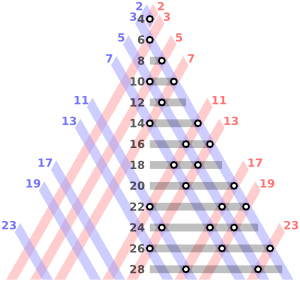

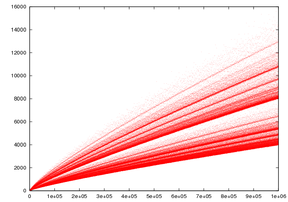













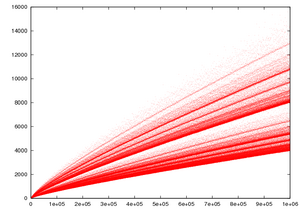

![{\displaystyle 1{\big /}{\big [}\ln m\,\ln(n-m){\big ]}}](https://wikimedia.org/api/rest_v1/media/math/render/svg/ebd3400044de44f8fc6c9c4a5830d94c5719a92d)







